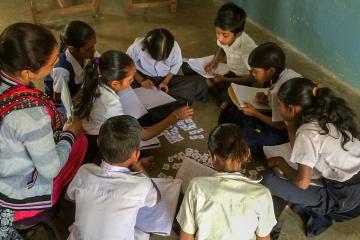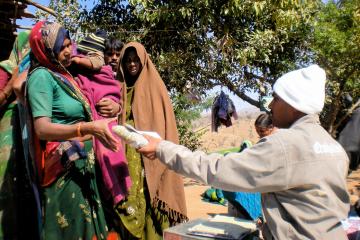
It improved lives elsewhere. Will it here?
Adapted from a TEDx talk delivered in November 2017.
TED is about ideas worth spreading.
But which ideas are worth spreading? Ideas from where? When we try to solve some of the biggest challenges our societies face, our first instinct is to look at what worked elsewhere. But can we really teach math like they do in Singapore? Or design a health program like they have in Sweden?
Often these questions lead to a hopeless conclusion: No other place is identical to our city, or state, or country. So do we have to start from scratch, instead of tapping into ideas worth spreading from somewhere else? Test an idea out all over again, here?
But the question isn’t where this idea came from, but why it worked. What underlying lessons about human behavior does this idea expose? What can we learn not about place, but about people? I focus on exactly that question at J-PAL. Instead of asking, "What’s the same about place," we ask, "What’s the same about people?"
Let’s take a step back and unpack two examples, examining why people changed their behavior.
An economist at the University of Chicago named Richard Thaler won a Nobel Prize this year for his research on human behavior. One of his biggest insights is simply that people like to procrastinate.
That might seem obvious, but it really matters when we decide how to tackle some of the toughest problems in the world. For example, it can make the difference between a healthy and a very sick child.
We know that one of the cheapest ways to save a child’s life is with immunizations. But in some areas of the world, even when immunizations are available and free, kids aren’t getting fully immunized.
A decade ago, our lab was working in the Udaipur district in the Indian state of Rajasthan, where only 6 percent of children received all their immunizations. We asked why so few kids were fully immunized. The immunizations were available and free, and when kids got sick, their parents took them to the doctor and spent a lot of money on medical care.
We thought the problem might lie in going from intention to action—for example, finding the time to walk to the clinic to get your child immunized. Maybe when you arrive the nurse is out, so you have to come back again. So you decide you’ll get around to it soon, but you put it off, until eventually you miss the window.
If that was the problem, we thought maybe we could give parents a reason to stop putting it off.
We tested this idea with a randomized evaluation, which is the same method as experiments to test new medical treatments. We worked with a local NGO, Seva Mandir, who has been working in Udaipur for fifty years and really understands the local context.
We tested this idea across 134 villages. In some of these villages, Seva Mandir organized a monthly camp where parents could bring their kids to get immunized and they knew a nurse was going to be there. In others, they organized the camp and also gave parents a kilo of lentils each time they came. The rest of the villages were the comparison group; it was business as usual.
Now, if I really don’t want to get my kid immunized, a small bag of lentils isn’t going to change my mind.
But if the problem is that I keep postponing a visit to the clinic, then I might decide to come in today instead of tomorrow so I can get that kilo of lentils.
And it turns out that worked really well. In the business-as-usual villages, only 6 percent of kids got all their shots. When we held the immunization camps, full immunization jumped to 18 percent. And when we added the lentils—the incentive to act today—six times as many kids were immunized. It turned out that when we added the lentils, the cost per shot was lower, because the camps were so much busier.
When we found a way to overcome procrastination—a very simple problem, but one that’s common to us all—six times as many kids got fully immunized.
How would you decide whether to try these incentives for immunization in a new place? What questions would you ask?
The question is not “Do people eat lentils there?” We can swap out the lentils for something else. We’re currently trying this with mobile phone credits in Pakistan and a local favorite, peanut butter and cereal, in Sierra Leone. The question is “Do people just need a reason to get their kids vaccinated today, instead of tomorrow?”
This works for more than vaccination. Whether it’s a nudge to quit smoking or to remember to treat your water so it’s safe to drink, we’ve seen small incentives convince people to act today instead of tomorrow all over the globe. When you focus on the underlying reason that changed behavior, you can better answer the question of whether this idea might work for you, wherever you are.
Now let’s look at another case where solving a common underlying problem helped us find a solution that worked across very different contexts.
We learn best when we’re taught at our level. That sounds obvious, right? But that’s not the reality many kids face in school.
Here are some examples of what kids learn in 10th grade:
- If 3x–10=24, then x=?
- For all a and b, 6a2b3 – 3a2b is equivalent to which of the following expressions?
Here are some problems we’ve seen students in those same 10th grade classrooms not be able to solve:
- 8+14–7=?
- 7x4=?
Imagine sitting in a classroom, day after day, trying to tackle multivariable algebra when you’re still struggling with simple addition.
Many have looked at this gap and drawn a hopeless conclusion. When programs aimed at helping high school kids who are behind grade-level are rigorously evaluated, most have failed to move the needle on learning outcomes. So if we don’t get kids on the same level in preschool, is it too late?
But what if it’s not that students who have fallen behind can’t learn, and it’s not that teachers in struggling classrooms can’t teach. It’s a mismatch.
It’s a mismatch between what students are expected to learn and the level they’re actually at today. And it turns out that there are straightforward, effective ways to address that mismatch.
We were really interested in a model used at Match Public Charter School in Boston, one of the top high schools in the country. One of their founding principles is intensive tutoring. Students spend time every day meeting with a tutor either individually or in small groups to work on material at their own level and at their own pace.
We’d seen programs in other parts of the world that approached education in a similar way lead to dramatic gains in learning. We call it “teaching at the right level.”
In Kenya, we saw that grouping students into classes based on their initial learning levels (instead of age or grade) helped students in every group learn more.
In India, a prominent non-governmental organization called Pratham enlisted local volunteers to tutor young children in basic reading and math skills. The program helped children who had fallen years behind catch up relatively quickly. We tested this in different settings: rural and urban, instruction by volunteers or government teachers, during the school day or during summer break. The results have been consistently positive.
So when our Education Lab colleagues were working with Chicago Public Schools to help high school boys who had fallen behind do better in school, they thought a version of teaching at the right level could be a good fit.
They were drawing on research done in places no one would categorize as similar to Chicago. But when we look at the underlying mechanisms that help struggling students catch up—why these programs worked—we thought the same factors could be at play.
There was a common underlying problem across Kenya, India, and Chicago: Kids were attending school at relatively high rates, but many had fallen years behind. Their teachers were incentivized to teach grade-level material, instead of the basic skills that some of their students were still struggling with.
Together with the nonprofit SAGA Innovations, Chicago tried out Match’s tutoring model, providing two-on-one tutoring for high school boys who had fallen years behind the curriculum. It worked. Boys who received tutoring learned almost two extra years of math in a single year. There were impacts beyond just math. They were less likely to fail other classes or even to be arrested for a violent crime.
These are some of the biggest learning gains for high school students that we’ve seen in rigorously tested programs.
When kids in Kenya, in India, in Chicago, and in Boston were taught at their level, they caught up. That’s not groundbreaking. It’s simple. It’s effective. And the lesson holds across radically different locations.
Am I suggesting that every school in the world start a targeted tutoring program? Not necessarily. But if we get stuck on location and think that Chicago can’t learn from India, we’ll miss out on many great ideas.
In the same way, if we’d focused on the fact that food incentives weren’t practical in Pakistan or lentils weren’t the right food in Sierra Leone, we would have missed the chance to try the same concept, but with something that makes sense locally like mobile phone credits or peanut butter.
There are many ideas worth spreading. When we ask why people act the way they do, why they change their behavior, we can look past superficial differences in geography and learn important lessons from surprising places.
We can learn from surprising places when we stop thinking too much about place, and start thinking about people.

